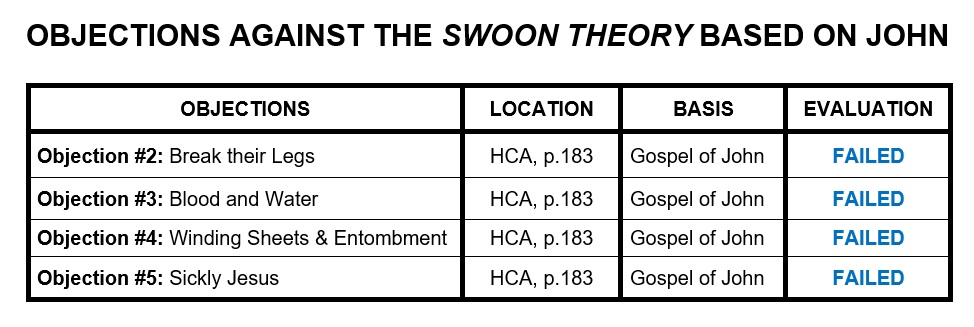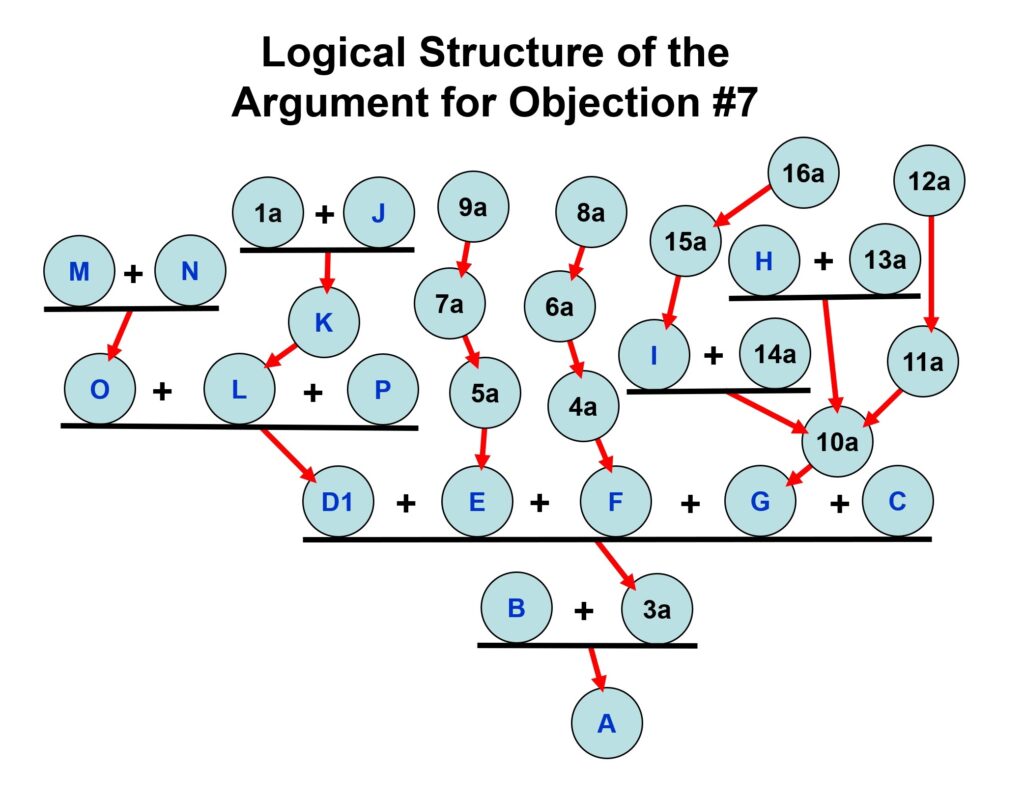Kreeft’s Case Against the Swoon Theory – Part 23: A Careful Analysis of Objection #7
WHERE WE ARE
In the Handbook of Christian Apologetics (hereafter: HCA), Peter Kreeft and Ronald Tacelli attempt to prove the resurrection of Jesus. An important part of their case for the resurrection of Jesus is an attempt to refute some skeptical theories, such as the Swoon Theory. If they FAIL to refute the Swoon Theory, then their case for the resurrection of Jesus also FAILS.
Kreeft and Tacelli raise nine objections against the Swoon Theory, and I have previously examined four objections that they based on passages from the Gospel of John. Here are the conclusions I have reached about those four objections:

See the post below for links to my posts about the above four objections:
Evaluation of the Objections Based on John
In more recent posts, I have moved on to analyze and evaluate three objections by Kreeft and Tacelli that are based on passages from other Gospels:

In Part 19 of this series, I presented a careful analysis of the argument constituting Objection #6 (Who Overpowered the Guards?) by Peter Kreeft and Ronald Tacelli.
In Part 20 of this series, I showed that premise (G) was FALSE, and thus that the core argument of Objection #6 is UNSOUND and should be rejected. Therefore, I showed that Objection #6 against the Swoon Theory FAILS.
In Part 21 of this series, I showed that the key premise (D) is also FALSE. That gave us a second very good reason to conclude that the core argument of Objection #6 is UNSOUND and should be rejected. Because we have two very good reasons to reject the core argument of this objection, it is clear that Objection #6 (Who Overpowered the Guards?) against the Swoon Theory FAILS.
In Part 22 of this series, I showed that the two sub-arguments that Kreeft and Tacelli gave in support of the key premise (F) are both UNSOUND and should be rejected. They failed to provide us a good reason to believe that the key premise (F) is true. However, premise (F) could be considered probably true, because there probably were no Roman soldiers guarding the tomb in the first place.
In this current post, I will present a careful analysis of the argument constituting Objection #7 (Who Moved the Stone?) against the Swoon Theory.
THE ARGUMENT FOR OBJECTION #7 (WHO MOVED THE STONE?)
Here is Kreeft and Tacelli’s presentation of Objection #7 (Who Moved the Stone?) against the Swoon Theory:
How could a swooning half-dead man have moved the great stone at the door of the tomb? Who moved the stone if not an angel? No one has ever answered that question. Neither the Jews nor the Romans would move it, for it was in both their interests to keep the tomb sealed: the Jews had the stone put there in the first place, and the Roman guards would be killed if they let the body “escape.”
The story the Jewish authorities spread, that the guards fell asleep and the disciples stole the body (Mt 28:11-15), is unbelievable. Roman guards would not fall asleep on a job like that; if they did, they would lose their lives. And even if they did fall asleep, the crowd and the effort and the noise it would have taken to move an enormous boulder would have wakened them. Furthermore, we are again into the conspiracy theory, with all its unanswerable difficulties (see next section).
(HCA, p. 183-184)
A CAREFUL ANALYSIS OF THE ARGUMENT FOR OBJECTION #7
After following my own process of careful argument analysis, I produced an argument diagram of this objection that includes fifteen stated premises, and sixteen unstated premises or assumptions, and that is organized into nineteen inferences or sub-arguments:

THE STATED PREMISES OF OBJECTION #7
1a. A weak and frail half-dead man would have been unable to have moved the great stone at the door of Jesus’ tomb on the weekend after Jesus was crucified.
3a. There is no plausible natural explanation for how the stone was moved from the door of Jesus’ tomb on the weekend after Jesus was crucified.
4a. The Jewish authorities in Jerusalem would NOT have moved the stone from the door of Jesus’ tomb on the weekend after Jesus was crucified.
5a. The Roman soldiers who were guarding Jesus’ tomb would NOT have moved the stone from the door of Jesus’ tomb on the weekend after Jesus was crucified.
6a. It was in the interest of the Jewish authorities in Jerusalem to keep the tomb of Jesus sealed on the weekend after Jesus was crucified.
7a. It was in the interest of the Roman soldiers who were guarding Jesus’ tomb to keep the tomb of Jesus sealed on the weekend after Jesus was crucified.
8a. The Jewish authorities in Jerusalem had the stone put in place at the door of Jesus’ tomb in the first place.
9a. The Roman soldiers who were guarding Jesus’ tomb would be killed if they let Jesus leave the tomb or if they let someone take Jesus’ body from the tomb on the weekend after Jesus was crucified.
10a. The story that the Roman soldiers who were guarding Jesus’ tomb fell asleep while on duty on the weekend after Jesus was crucified and that some (or all) of Jesus’ eleven remaining disciples moved the stone from the door of Jesus’ tomb and stole the body of Jesus is unbelievable.
11a. The Roman soldiers who were guarding Jesus’ tomb would NOT have fallen asleep while on duty to guard Jesus’ tomb on the weekend after Jesus was crucified.
12a. IF the Roman soldiers who were guarding Jesus’ tomb fell asleep while on duty to guard Jesus’ tomb on the weekend after Jesus was crucified, THEN the Roman soldiers who were guarding Jesus’ tomb would have been executed for failure to perform their guard duty.
13a. IF the Roman soldiers who were guarding Jesus’ tomb fell asleep while on duty to guard Jesus’ tomb on the weekend after Jesus was crucified and some (or all) of Jesus’ eleven remaining disciples attempted to move the stone from the door of Jesus’ tomb on the weekend after Jesus was crucified, THEN the noise from the attempt to move the stone from the door of Jesus’ tomb would have wakened the Roman soldiers who were guarding Jesus’ tomb.
14a. IF the Roman soldiers who were guarding Jesus’ tomb fell asleep while on duty on the weekend after Jesus was crucified and some (or all) of Jesus’ eleven remaining disciples moved the stone from the door of Jesus’ tomb on the weekend after Jesus was crucified and stole the body of Jesus, THEN the Conspiracy Theory is true.
15a. The Conspiracy Theory has a number of unanswerable difficulties.
16a. In Chapter 8 of HCA, Kreeft and Tacelli show that the Conspiracy Theory has a number of unanswerable difficulties.
THE UNSTATED ASSUMPTIONS/PREMISES OF OBJECTION #7
A. The Swoon Theory is FALSE.
B. IF the Swoon Theory is true, THEN there is a plausible natural explanation for how the stone was moved from the door of Jesus’ tomb on the weekend after Jesus was crucified.
C. There are only four possible natural explanations for how the stone was moved from the door of Jesus’ tomb on the weekend after Jesus was crucified: (a) Jesus moved the stone, (b) the Roman soldiers moved the stone, (c) the Jewish authorities in Jerusalem moved the stone, or (d) some (or all) of Jesus’ remaining eleven disciples moved the stone.
D1. Jesus did NOT move the stone from the door of Jesus’ tomb on the weekend after Jesus was crucified (unless Jesus experienced a supernatural resurrection).
E. The Roman soldiers did NOT move the stone from the door of Jesus’ tomb on the weekend after Jesus was crucified.
F. The Jewish authorities in Jerusalem did NOT move the stone from the door of Jesus’ tomb on the weekend after Jesus was crucified.
G. It is NOT the case that some or all of Jesus’ eleven remaining disciples moved the stone from the door of Jesus’ tomb on the weekend after Jesus was crucified.
H. IF the Roman soldiers who were guarding Jesus’ tomb on the weekend after Jesus was crucified were wakened by the noise from the attempt of some (or all) of Jesus’ eleven remaining disciples to move the stone from the door of Jesus tomb, THEN Roman soldiers would have prevented some (or all) of Jesus’ eleven remaining disciples from moving the stone from the door of Jesus’ tomb.
I. It is NOT the case that the Conspiracy Theory is true.
J. IF the Swoon Theory is true, THEN Jesus would have been a weak and frail half-dead man on the weekend after Jesus was crucified.
K. IF the Swoon Theory is true, THEN Jesus would have been unable to have moved the great stone at the door of Jesus’ tomb on the weekend after Jesus was crucified.
L. IF the Swoon Theory is true, THEN Jesus did NOT move the stone from the door at Jesus’ tomb on the weekend after he was crucified.
M. IF the Swoon Theory is false, THEN Jesus died on the cross, and thus (apart from a supernatural resurrection), Jesus would have been unable to move the stone from the door of his tomb on the weekend after he was crucified.
N. IF Jesus would have been unable to move the stone from the door of his tomb on the weekend after he was crucified (unless he experienced a supernatural resurrection), THEN Jesus did NOT move the stone from the door of Jesus’ tomb on the weekend after he was crucified (unless he experienced a supernatural resurrection).
O. IF the Swoon Theory is false, THEN Jesus did NOT move the stone from the door of Jesus’ tomb on the weekend after he was crucified (unless he experienced a supernatural resurrection).
P. EITHER the Swoon Theory is true OR the Swoon Theory is false.
In the next post of this series, I will begin to critically evaluate this argument for Objection #7 against the Swoon Theory.
